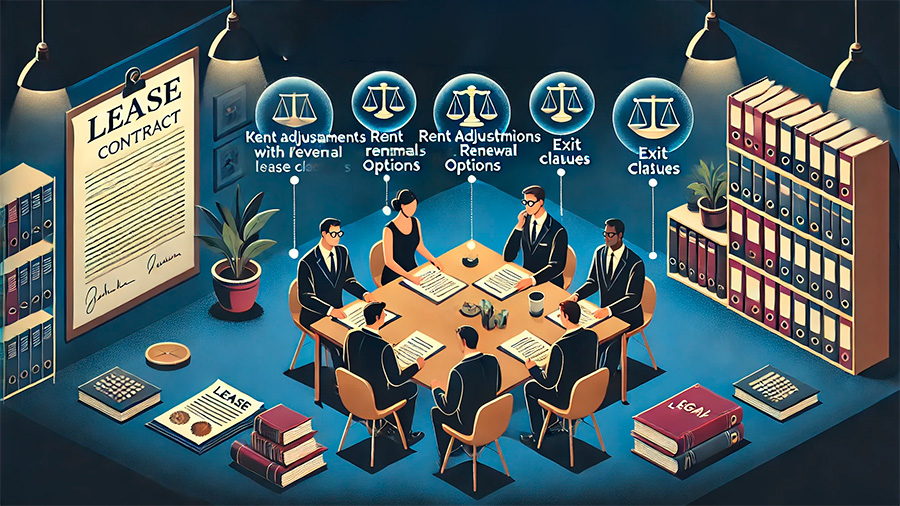Negotiating a lease for commercial premises is a critical step in securing a space that supports your business growth while protecting your financial interests. Commercial leases often involve complex terms and long-term commitments, so understanding how to approach the negotiation process is key to securing a deal that benefits your business. From rent and lease duration to build-out allowances and maintenance responsibilities, negotiating favorable lease terms requires preparation, strategy, and a thorough understanding of your business needs. In this article, we’ll explore how to approach these negotiations to secure terms that align with your goals.
Understanding the Types of Commercial Leases
Before entering negotiations, it’s important to understand the different types of commercial leases, as they can vary significantly in structure and cost. Common types of commercial leases include gross leases, net leases, and percentage leases, each with its own set of terms regarding rent, operating expenses, and other costs. Knowing the differences between these lease structures will help you negotiate terms that fit your business model.
Gross Leases
In a gross lease, the tenant pays a fixed rent, while the landlord covers most or all of the building’s operating expenses, such as property taxes, insurance, and maintenance. This type of lease offers simplicity for tenants, as they only need to budget for one predictable payment each month. However, because the landlord is responsible for expenses, the base rent in a gross lease is often higher than in other lease structures.
Net Leases
Net leases, which include single-net, double-net, and triple-net leases, shift some or all of the operating expenses to the tenant. In a triple-net lease, for example, the tenant is responsible for paying rent plus a share of property taxes, insurance, and maintenance costs. These leases can offer lower base rent but come with the added responsibility of fluctuating expenses. Understanding the potential costs involved in a net lease is crucial when negotiating the terms.
Percentage Leases
Percentage leases are common in retail spaces, where tenants pay a base rent plus a percentage of their gross sales. This structure aligns the interests of both the landlord and tenant, as the landlord benefits from the tenant’s business success. If your business is in a high-growth phase, a percentage lease might offer flexibility, but you’ll need to carefully negotiate the percentage of sales and any caps on rent increases.

Key Factors to Consider When Negotiating Lease Terms
Negotiating a commercial lease involves balancing multiple factors, including rent, lease duration, renewal options, and additional costs. Before entering negotiations, it’s essential to clearly define your business needs and understand which aspects of the lease are most important to your long-term success.
Rent and Rent Increases
Rent is often the first point of negotiation in a commercial lease. While landlords typically set a base rent, there is often room for negotiation, particularly if the market is soft or the property has been vacant for a while. Researching comparable properties in the area will give you leverage to negotiate a fair rate. Additionally, it’s important to discuss rent escalations, which are periodic increases in rent. Landlords may propose annual rent increases tied to inflation or a fixed percentage, so it’s essential to negotiate a cap on these increases to avoid unexpected costs in the future.
Lease Duration and Flexibility
The length of the lease is another critical aspect to negotiate. While landlords often prefer longer-term leases for stability, you should assess how the lease duration aligns with your business goals. If your business is in its early stages or you anticipate needing more flexibility, a shorter lease with renewal options might be ideal. You can also negotiate for favorable renewal terms, such as the right to renew the lease at a predetermined rate, which protects you from steep rent increases when the lease ends.
Tenant Improvements and Build-Out Allowances
In many cases, commercial spaces need to be customized or renovated to suit the specific needs of your business. When negotiating the lease, discuss tenant improvement allowances (TIAs), which are funds provided by the landlord to cover build-out costs. Negotiate for the maximum TIA possible, as this can save your business significant upfront costs. If the landlord is unwilling to provide a sufficient allowance, try negotiating for rent-free periods during the build-out phase to offset the cost.
Negotiating Maintenance and Operating Costs
One of the most important but often overlooked aspects of a commercial lease is who will be responsible for maintenance, repairs, and operating costs. These expenses can add up quickly, so it’s crucial to clarify these responsibilities during the negotiation process.
Common Area Maintenance (CAM) Fees
If you’re leasing space in a multi-tenant building, you’ll likely be responsible for a portion of the common area maintenance (CAM) fees. These fees cover the upkeep of shared spaces such as lobbies, hallways, and parking lots. CAM fees can be unpredictable and fluctuate based on the building’s needs, so it’s important to negotiate a cap on how much these fees can increase annually. Additionally, ask for a detailed breakdown of what the CAM fees cover and ensure that your share is proportional to the size of your leased space.
Maintenance and Repairs
In net leases, tenants are often responsible for the maintenance and repair of their leased space, but the scope of these responsibilities can vary. Clarify which repairs and maintenance you’ll be responsible for, and negotiate terms that limit your liability for major repairs. For example, if the HVAC system or plumbing requires extensive repairs, you may be able to negotiate that the landlord covers the cost. Additionally, if you’re responsible for routine maintenance, try to include a clause that requires the landlord to perform inspections or upgrades on major systems to prevent costly repairs down the line.

Protecting Your Business with Favorable Lease Clauses
Certain lease clauses can offer your business valuable protection and flexibility, so it’s essential to ensure they are included in your agreement. These clauses can help you navigate unforeseen challenges or changes in your business needs.
Sublease and Assignment Clauses
If your business grows faster than anticipated or you need to relocate, having the ability to sublease or assign your lease to another tenant can provide flexibility. Subleasing allows you to rent out part or all of your space to another business, while assignment transfers the entire lease to a new tenant. Landlords may be hesitant to allow subleasing or assignment, so it’s important to negotiate for these rights upfront. Make sure any sublease or assignment clause doesn’t require the landlord’s unreasonable approval or additional fees.
Exclusive Use Clauses
An exclusive use clause can protect your business from competition within the same property. This clause prevents the landlord from leasing space to a competitor, ensuring that your business is the only one of its type in the building or complex. If your business relies on foot traffic or niche services, an exclusive use clause can be critical in maintaining your customer base and protecting your revenue.
Termination and Exit Clauses
Having a clear exit strategy is essential when negotiating a commercial lease. A termination or exit clause allows you to end the lease early under specific conditions, such as if your business underperforms or you need to relocate. While landlords are often reluctant to include termination clauses, you may be able to negotiate for an early termination option by offering compensation, such as a few months’ rent, to mitigate the landlord’s risk.
Strategies for Effective Lease Negotiation
Negotiating a commercial lease can be a complex and time-consuming process, but with the right strategies, you can secure terms that benefit your business.
Do Your Market Research
Before entering negotiations, research the local commercial real estate market to understand average rental rates, vacancy rates, and demand trends. This knowledge will give you leverage in negotiations, especially if the property has been vacant for some time or if similar properties in the area are renting for less. Be prepared to present data to the landlord that supports your request for a lower rent or more favorable terms.
Work with a Commercial Real Estate Broker
A commercial real estate broker can be an invaluable asset during lease negotiations. Brokers have in-depth knowledge of the local market, access to off-market listings, and experience negotiating favorable lease terms. Additionally, they can help you identify potential issues in the lease agreement and advocate on your behalf. While brokers charge a commission, their expertise can save you money in the long run by securing better terms.
Be Willing to Walk Away
One of the most powerful negotiation strategies is being willing to walk away if the terms don’t meet your needs. If a landlord senses that you’re desperate to secure the space, they may be less inclined to offer concessions. However, by showing that you have other options and are willing to explore them, you can gain leverage in the negotiation process. Be prepared to walk away if the terms aren’t favorable—there are always other opportunities in the market.
Successfully negotiating a commercial lease requires preparation, strategy, and a clear understanding of your business’s needs. By focusing on key areas like rent, lease duration, and maintenance responsibilities, and by protecting yourself with essential clauses, you can secure a lease that supports your business growth while minimizing financial risks.





